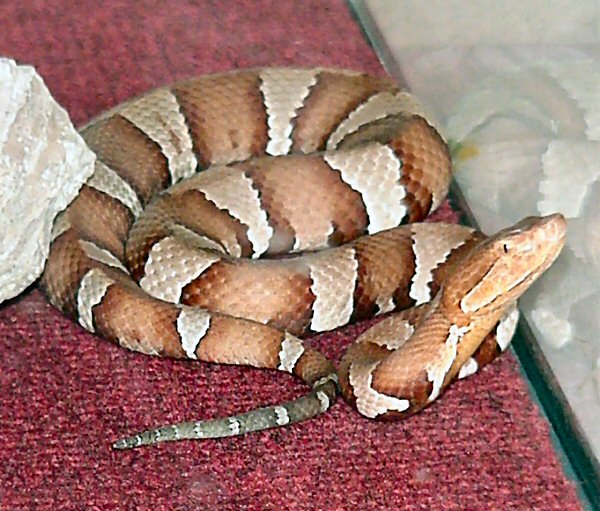Wildlife North America . com North American Animals - mamals, birds, reptiles, insects |
Trans-pecos Copperhead (Agkistrodon contortrix pictigaster)
Trans-Pecos Copperhead in captivity Photograph by LA Dawson. Some rights reserved. (view image details)
TRANS-PECOS COPPERHEAD FACTS
DescriptionThe Trans-pecos Copperhead is light tan with brown wide cross bands. The band color varies from red-brown to gray-brown depending on locality. It is similar to A. contortrix laticinctus, the Broad-banded Copperhead. The main difference is that the Trans-Pecos Copperhead usually has a black and white patterned underside, while the Broad-banded usually has a plain white or lightly patterned underside. It does not have hourglass shaped bands like other subspecies of Copperheads. Young snakes have a bright greenish-yellow tail tip. Size length 70cm - 100cm Environment rocky, lightly vegetated, canyon areas Food small rodents, ground birds, lizards, large insects, frogs and other small snakes Breeding live bearing with litters of up to eight young. The newborn snakes are left to fend for themselves and have fully developed senses and venom. Range western Texas, northern Chihuahua and Coahuila in Mexico. Notes Bites to humans are very uncommon. Symptoms of bites include intense pain, tingling, throbbing, swelling, and severe nausea. Bite can cause muscle damage. Seek immediate medical attention if bitten. Classification
Relatives in same Genus Common Cantil (A. bilineatus bilineatus) Ornate Cantil (A. bilineatus taylori) Southern Copperhead (A. contortrix contortrix) Broad-banded Copperhead (A. contortrix laticinctus) Northern Copperhead (A. contortrix mokasen) Osage Copperhead (A. contortrix phaeogaster) Florida Cottonmouth (A. piscivorus conanti) Western Cottonmouth (A. piscivorus leucostoma) Eastern Cottonmouth (A. piscivorus piscivorus) Home | Mammals | Reptiles | Birds | Insects | Privacy Policy | Disclaimer | Contact Us |